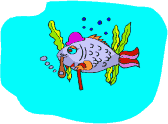 |
Fishing Stories from Ned Kehde |
|
Fishing Reports Reader's Nook Angler's Academy Club Corner Tournament Trail Success Stories Kansas Angler Info Angler Links |
Submitted by Ned Kehde - September
15, 2000 At least that's the gist of the discouraging news that a gathering of ardent crappie anglers learned from Kirk Tjelmeland, a Kansas Wildlife and Parks fisheries biologist, at Topeka on Sept. 14. Chatt Martin, a crappie guide and tournament fisherman from Lawrence, called Tjelmeland's description of the plight of Perry's crappie disheartening. Several other anglers said it was similar to going to your doctor for a check up, and the doctor reporting that you are afflicted with some incurable malady that will send you quickly to your grave. Another clutch of incredulous anglers said that just nine years ago Perry was the best crappie lake in the world. Therefore, they were astonished to learn that the aging process, which are layman's words for eutrophication, could work so swiftly. Since 1995, it has been obvious to scores of the savviest anglers that Perry's crappie population was flagging. And Terry Hinson of Silver Lake, who has caught inestimable numbers of Perry's crappie since 1985, said that the summer of 2000 was the worst crappie fishing ever. Despite this rather precipitous downturn, most of the anglers at Perry assumed that the decline could be halted, and the population could eventually be resurrected to its world-class levels of 1991-92. Some anglers presumed that the effects of eutrophicaton on the crappie could be stemmed by establishing a stringent creel limit and perhaps raising the current 10-inch length limit to 11 inches. But according to Tjlmeland and his fellow KWP biologists, rigorous creel and size limits won't help, because anglers only harvest 10 percent of the crappie population annually. In addition, crappie are such a fragile creatures that many perish after being caught and released. The crappie mortality rate at Perry ranges from 50 to 80 percent a year. What's more, they are so short-lived that very few of them live more than three years. On top of that, it now takes four years for most crappie to grow 10 inches, and that's a byproduct of eutrophicaton and turbidity. Thus, a 10-inch or longer size limit is useless. The only hope for a minor rejuvenation of Perry's crappie population rest with a more enlightened management of the lake's water levels, and that is in the hands of the U.S. Army Corps of Engineers. Such a plan would slowly flood the weedy shorelines during the spawn, giving the young crappie a place hide from predators. But since Perry is a primarily a flood-control reservoir, Mother Nature can easily toss a monkey wrench into those tenuous plans. As Martin returned to Lawrence after the meeting, he was so downcast that the only scenario that he could devise to revitalize Perry was similar to the piscatorial rebirth that occurred at Webster, Kirwin and Cedar Bluff reservoirs in western Kansas in 1993. To accomplish such a feat, northeastern Kansas must suffer through several years of drought, causing Perry's water level to decrease in size from 11,000 acres to about 8,000 acres. After the exposed terrain sprouts a multitude of luxurious willows, cottonwoods and brush, Mother Nature floods them with a copious amount of rain, creating virtually a new lake again. Then like all new lakes, Perry would produce big crappie galore. But that severe drought-and-flood scenario is unlikely. So Martin and others will have to live with a dying lake and mediocre to paltry fishing. |
|
Kansas Angler Online Sponsor  |
Copyright 2000 by The Kansas Angler - P.O. Box 12261 - Wichita, KS 67211 - Phone 316-265-5551 Questions or problems with this website should be directed the link above. This Page Last Updated on date shown at top of page. |

